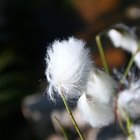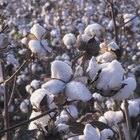Cotton
Cotton fabric is made from the fibers of the cotton plant. Grown naturally and harvested as a cash crop, cotton comes from all over the world, but notably from Africa, South America, and the southern part of the United States. Once the cotton plant is harvested, the fibers of cotton are gleaned from the rest of the plant. The soft, squishy cotton fibers are then washed, dried, and woven into yarn by a machine. The yarn is brushed to remove further impurities, and the yarn is then put on a loom and woven into cotton fabric.
Polyester
Polyester fibers, unlike cotton fibers, are made from petrochemicals. Dimethyl teraphthalate is reacted with ethylene glycol with a catalyst at a temperature between 150 and 210 degrees C. The chemical that results from this (which is an alcohol) is then combined with terephthalic acid, and the resulting, molten polyester is siphoned off in ribbons from the reaction. The ribbons are allowed to dry completely, then they are cut into chips, and melted at 260 to 270 degrees C. Then once again molten polyester is poured through a met spinner, which forces the polyester through small, round openings to turn the polyester into yarn. Other chemicals may be added to it at this point to strengthen it, if necessary.
Poly Cotton
Poly Cotton fabric is made of a combination of cotton and polyester. It combines the benefits of cotton, such as its absorbency and breathing qualities, with the toughness and lack of wrinkling that polyester possesses. In order to weave a poly cotton blend, yarn of both cotton and polyester are put on a loom. The loom is then used to weave a single fabric out of both the cotton and the polyester yarn, creating a new fabric that is sometimes called poly cotton. Most common types of poly cotton fabric boast slightly more cotton content than polyester content in the end.
Related Articles

What Is the Difference Between Acrylic ...

What Is a Synthetic Polyester Fabric?

Definition of Polyester Staple Fiber

What Is Arnel Vintage Material Fabric?

Information About Cotton Fabric

Types of Cotton Fabric

Types of Polyester Fabric

Cotton Vs. Permanent Press Fabric

How to Dye Polyester Fabric

How Is Cotton Made?

Define Cotton Silk Fabric

What Are Fire Resistant Clothes Made Of?

How to Keep Cotton Pants From Shrinking

How to Get Fuzz Out of Polyester

How Is Silk Made Into Fabric?

How Much of the World's Clothing Is ...

How Is Wool Turned Into Fabric?

How to Remove Liquid Downy Stains

How to Take Care of 100% Cotton ...

Denim vs. Denim Blends
Writer Bio
Neal Litherland is an author, blogger and occasional ghostwriter. His experience includes comics, role playing games and a variety of other projects as well. He holds a bachelor's degree in criminal justice from Indiana University, and resides in Northwest Indiana.